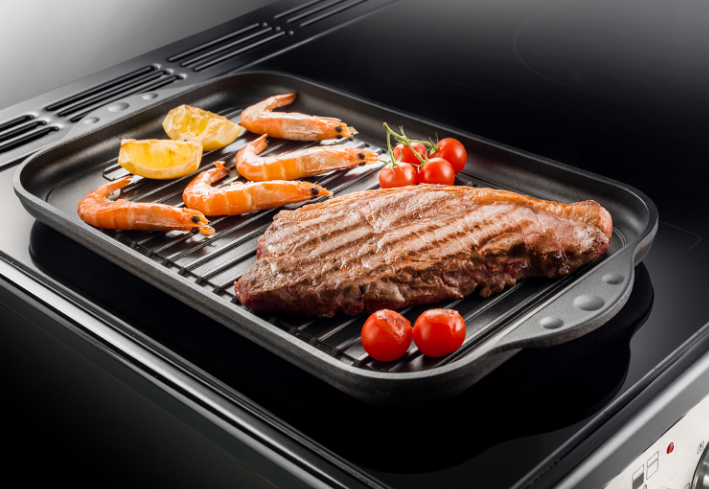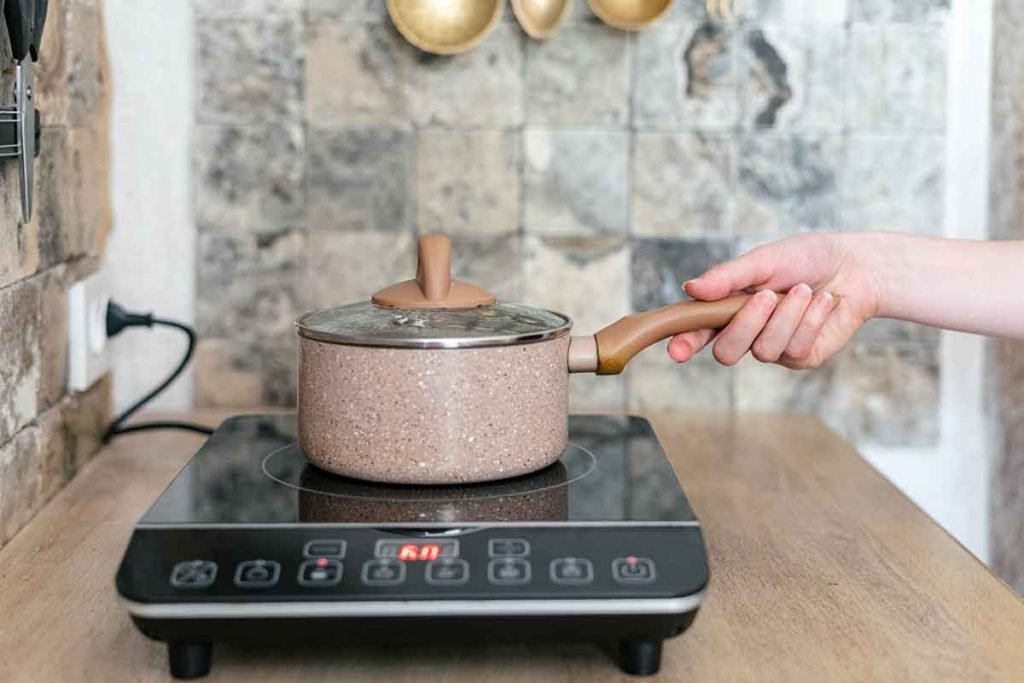Nothing can dampen my mood faster than biting through steak that I’ve prepared for hours, only to discover it’s tough, chewy, and utterly tasteless. In the past, I encountered this problem many times. For me, preparing steak was like playing Russian roulette. Sometimes, I got my mind blown away, but more often than not, I ended up high and dry.
But back then, I wasn’t aware of the perks of cooking steak with an induction cooktop. I used appliances like electric coil stoves, which, in a single word, SUCK! Then someone brought me up to speed and I installed an induction cooktop. Since then, I’ve been cooking my ribeye and filet mignon on my induction hob. The outcome? Tender, evenly-cooked steak with an irresistibly alluring crust.
Step-by-Step Process of Cooking Steak on an Induction Stove
Before we go to the actual steps, I’d first recommend that you choose your steak wisely. A good cut is synonymous with a steakhouse-quality meal. These are not my words, but the words of Heartsone Farm owner, Dan Kaplan. His farm produces quality grass-fed beef.
“There’s nothing you can do to make a bad, flavorless steak palatable. The whole point is to bring out the unique, delicious essence of the meat.” he said.
Now, let’s jump into the steps: You can prepare flawless steak by following the process below. I always stick by it, and it has never let me down.
Ingredients
- Steak of your choice (ribeye, strip, filet mignon, etc.)
- Salt and pepper
- Butter or oil for searing Equipment
Equipment
- Induction Cooktop
- Cast iron or stainless steel skillet
- Meat thermometer Steps
Step 1: Thaw Your Steak
I often buy meat in bulk and store it in the freezer to avoid making too many grocery runs. If you do the same, you must thaw your steak before cooking it. If you are in no hurry, take it out of the freezer and submerge it in room-temperature water for around 30 minutes or pop it into the microwave and hit the defrost button for 10 minutes.
On the other hand, you can let the frozen steak thaw in a refrigerator for around 24 hours. I highly recommend this method since it’s the safest, despite taking longer.
Step 2: Season the Steak
Seasoning your steak makes it more tender and enhances its flavor. Seasoning a steak calls for different spices. Depending on your preferences, you can use anything from salt and pepper to minced onion or garlic powder.
After seasoning the meat, let it sit in your fridge’s drying rack for up to 24 hours. I recommend that because it makes the steak juicier and allows the outside to achieve a delicious crust.
Step 3: Preheat a Grilling Pan
Preheating the pan is the key to having that all-too-popular sear on your steak. Ensure you use an induction-ready pan with a thick, non-stick bottom.
Place the cookware on the induction cooktop and turn on the appliance. The best temperature for preheating a pan is 400-500 °F, which should be level 7-8 on an induction stove. Let the pan sit on the cooktop for 5 minutes.
Read Our Article on Best Grilling Pans for Induction Cooktop
Step 4: Add Oil
Once the pan is ready, add enough oil to coat the bottom. It will stop the meat from sticking to the pan and ensure the cooked steak has a crisp crust. And if you use flavored oil like butter-flavored oil, which I love, it will give your dish a unique, unforgettable flavor.
Step 5: Cook the Perfect Steak
While most chefs can swear by those flames of a gas cooktop that produce a flavorsome and caramelized crust, it’s still possible to get good results when you sear your hot frying pan on an induction hob. Place the steaks in your pan carefully not to crowd the pieces. If there’s no enough space, they’ll likely stew.
The duration of cooking will largely depend on your steak’s thickness, but we are going to go with a 2cm thickness for this guide.
- Rare – Cook each side for 2 minutes
- Medium rare – Cook each side for 3- 4 minutes
- Medium – Cook each side for 4 – 6 minutes each side
- Well done – Cook for 2 minutes on each side. Turn it down and then continue cooking for another 4 – 6 minutes on a medium heat
While preparing your stick, keep an eye on the clock. If, for instance, you are going for a well-done juicy piece, let one side sear for 2 minutes, then flip it and let the other do the same. Additionally, keep checking for doneness.
Once all sides are nicely browned, insert a meat thermometer to check for doneness. Remove from heat when it reaches your desired temperature (125 F for rare, 135 F for medium-rare).
Step 6: Enjoy
After ascertaining the steak is ready, I usually turn off the induction hob and let the meat rest for a few minutes. I’ve made this a habit after discovering that the internal juices in meat constrict while cooking. Allowing the steak to rest gives the juices enough time to be redistributed and reabsorbed. Otherwise, the juices pool out if you dig into your steak too soon, leaving you with dry meat.
What Temperature Do You Cook Steak on Induction?
Won’t lie; I love steak with a crunchy crust. If you do, too, use level 7-8 power level to sear the meat on an induction stove. Then, to avoid overcooking the exterior, whose aftermath is chewy meat, dial down the heat to medium and allow the steak to cook gently.
And don’t make the mistake I made while still a newbie. While cooking my first steak on an induction hob, I went with low heat because someone told me it would lead to a juicier steak. To my surprise, my much-awaited ribeye turned into an undercooked, crustless abomination.
What Cookware Do You Need to Cook Steak on an Induction Hob?
I have different induction-ready cookware in my kitchen. But, over the years, I’ve discovered that the best item for cooking steak on an induction cooktop is a heavy-duty, cast-iron grill pan.
I prefer this cookware because it has flawless heat distribution. Moreover, it can take extreme heat, a necessary ingredient in searing and browning steak. My pan has rims, which come in handy when I want to sauté larger steak cuts without splattering oil all over my cooktop.
Generally, though, use a meat thermometer to gauge the internal temperature of the steak:
- 120-130°F (49-54°C) for rare
- 130-140°F (54-60°C) for medium-rare
- 140-150°F (60-65°C) for medium
- 150-160°F (65-71°C) for medium-well
- 160°F (71°C) and above for well-done
Advantages of Cooking Steak on an Induction Cooktop
One of the most touted benefits of using induction cooktops to prepare anything, including steak, is even heat distribution, and I don’t doubt it. Since I started using an induction stove, my steak always comes out with uniform browning and zero hot spots.
Induction cooking has also saved me the headache of chewing through “black and blue” steak. Every time I start searing a juicy cut on my induction cooktop, my mind rests easy, knowing I don’t have to worry about eating meat with uncooked portions. And that is a good thing, considering that undercooked meat can cause food poisoning, among other health issues.
Final Thoughts
Since discovering that I can use an induction cooktop to prepare the steak of my dreams, I’ve never switched to any other appliance. It’s proven indispensable in ensuring my ribeye has a delicious crust and cooks evenly. But note that using this technique calls for an induction-ready grilling pan. If you don’t have it, it’s time to go shopping. Once it’s a part of your cookware, prepare a juicy steak with the tips outlined here.
Frequently Asked Questions
Can I Cook Steak on an Induction Cooktop?
Yes, you can cook steak on an induction cooktop. The precise temperature control of induction cooking can help you achieve a perfectly cooked steak.
What Type of Pan Should I Use?
Use a heavy-bottomed, oven-safe skillet or frying pan. Cast iron, stainless steel, and other induction-compatible pans work well.
Should I Season the Steak Before Cooking?
Yes, season the steak with salt and pepper or your preferred seasonings. You can also marinate it for extra flavor.
Do I Need to Bring the Steak to Room Temperature Before Cooking?
It’s a good idea to let the steak come close to room temperature before cooking. This ensures more even cooking.
Can I Finish Cooking in the Oven?
Yes, after searing both sides of the steak, you can transfer the skillet to a preheated oven to finish cooking. This is particularly useful for thicker cuts.
Should I Rest the Steak After Cooking?
Yes, let the steak rest for a few minutes before slicing. This allows the juices to redistribute, resulting in a juicier steak.
Can I Cook Different Types of Steak on the Induction Cooktop?
Yes, you can cook various types of steak, including ribeye, sirloin, filet mignon, and more, using the same basic technique.
Is Induction Cooking Faster than Other Methods?
Induction cooking heats up faster than traditional methods, but the cooking time for the steak will depend on its thickness and desired doneness.
What About Searing and Resting Times?
Searing times can vary based on your steak’s thickness and the desired doneness. As a general guide, sear each side for 2-4 minutes before finishing in the oven or reducing heat for thicker cuts. Let the steak rest for about 5-10 minutes.




